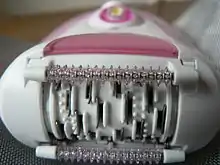Epilator
An epilator is an electrical device used to remove hair by mechanically grasping multiple hairs simultaneously and pulling them out. The way in which epilators pull out hair is similar to waxing, although unlike waxing, they do not remove cells from the epithelium of the epidermis. Aside from the spring in early spring-type epilators, there are no parts in epilators that require regular replacement. Epilators come in corded, rechargeable and battery-operated designs. The battery-operated devices can be used wet or dry. They may also come with various attachments, like a smaller head to help with epilation of hard-to-reach areas, or an exfoliation head that may help exfoliate the skin before and after epilation.

Epilation can be painful to some people because, as with waxing, it involves pulling hair out of the roots. Because of the pain involved being particularly bad on the first epilation of an area, some people prefer to have the area professionally waxed first, then use epilation to remove regrowth.[1] Wet and dry epilators are comparatively less painful to use as removing hair from wet skin involves less pain. If the pain is intolerable, using a numbing cream prior to hair removal will reduce the pain to a great extent. If the epilator allows for setting the speed of operation, keeping it at the lowest setting may also reduce pain involved in the process.
Types
Spring type

The first type of epilator was the original Epilady released in Israel, and manufactured by Mepro, in kibbutz Hagoshrim in 1986.[2] The design incorporated a coil spring, which was bowed into a curve such that the coils on one side of the spring were squeezed tightly together while on the other side the coils were spread apart. The motor in the epilady rotated the spring, causing it to flex as it rotated. Moving the rotating spring across the skin caused the hairs to be caught up in the spring and pulled out through hair follicles.[3]
Because the springs flexed continuously, they were subject to occasional failure and were sold separately as a replacement part.
Today, there are manual epilators designed for the face, that do not use a power supply. This design consists simply of a coil spring with two handles. The spring is then bowed into a curve and placed upon the unwanted facial hair whilst turning the handles. This caused the hairs to be caught between the coils of the springs and pulled out from the roots.
Rotating disc type
The Remington Lady Remington Smooth and Silky was designed to operate in a similar way to the spring type Epilady, except that a series of metal discs were used instead of a spring. It was the subject of extensive patent litigation in Europe due to a conceptual similarity to the spring type epilator.[4] The UK patent infringement case is known as Improver Corporation v Remington Consumer Product Limited [1990] F.S.R. 181.
Tweezer type

The rotating disc design has been refined such that, in modern designs, the plates are no longer complete discs. The head of a modern epilator incorporates a series of metal plates mounted in a plastic housing. The ends of the plates may be exposed at one or both sides of the housing. As the head rotates, the tips of the plates move together and apart once per revolution. This creates a tweezing effect, where the hair between the plates, when they close, is pulled as the plates rotate away from the skin, then released as the plates separate. This allows a continuous cycle of gripping, pulling, extracting and discarding the hair as the epilator is moved across the skin.
Depending upon the strength and brittleness of the hair, some may snap off rather than being pulled out. Because those hairs snap off just above the skin surface, they can look somewhat like stubble from shaving, but are far more sparsely spread because the other hairs have been pulled out entirely. As with waxing, because of the phases of growth that occur with hair, there is not as much regrowth following the first epilation. Regular epilation of regrowth is less painful than the initial epilation and the number of broken off hairs diminishes with regular epilation.
Wet use type
Many modern epilators have a built in rechargeable battery and are designed to be used either wet or dry. These types of devices are built to be used in or out of the shower or with an optional cream or gel. The use of a skin cream or gel is said to be helpful with reducing the pain and irritation associated with the dry use only devices.[5]
References
- Godfrey, Sheila (2001). The Principles and Practice of Electrical Epilation. Routledge. p. 113. ISBN 978-0750652261.
- Chartrand, Sabra (1988-10-10). "Israelis Revolutionize Hair Removal Industry". The New York Times. ISSN 0362-4331. Retrieved 2017-04-06.
- Adelman, Martin (2000). "The doctrine of equivalents and prosecution history estoppel: united states developments" (PDF). Archived from the original (PDF) on 30 December 2008. Retrieved 16 October 2015.
- Fisher, Matt (2007). Fundamentals of Patent Law: Interpretation and Scope of Protection. Bloomsbury Publishing. p. 246ff. ISBN 978-1847313812.
- Crumay, Hugh M. (1978-01-01). "Epilation". In F.A.C.P, Herbert Goldschmidt M. D. (ed.). Physical Modalities in Dermatologic Therapy. Springer New York. pp. 197–199. doi:10.1007/978-1-4612-6259-6_19. ISBN 9781461262619.